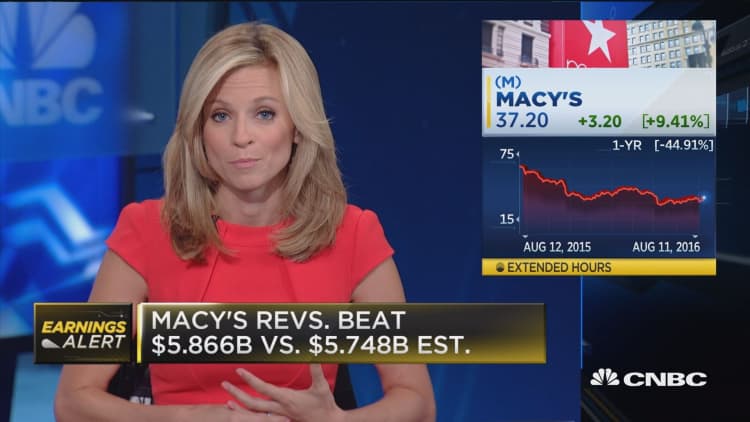
Retail investors can finally release that breath they've been holding in. Well, some of it at least.
Macy's CEO Terry Lundgren on Thursday delivered a long-awaited jolt to Wall Street, when he admitted the United States has too much square footage dedicated to retail. The company announced plans to shutter 100 of its 728 traditional Macy's stores — a strategy bearish investors have been begging the company to pursue for more than a year.
By Lundgren's own admission, industrywide there is 7.3 square feet of retail space per capita in the United States. That compares with roughly 1.3 square feet in the U.K. and 1.7 square feet in France.
This saturation has caused retailers to invest too little in many of their stores, particularly the ones that aren't delivering adequate returns. It's also tied up capital that could have been put toward better uses, such as investing in e-commerce. Meanwhile, it's dented their profitability.
Lundgren likewise applauded vendors Coach and Michael Kors for taking control of their brands, telling CNBC that they, too, need to make adjustments regarding their distribution. Both labels said earlier this week that they would trim the amount of merchandise they sell at department stores, saying these shops' excessive discounts are hurting their brands.
Macy's shares rocketed higher, after these announcements and better-than-expected fiscal second-quarter results. Shares of competitors including Kohl's, which likewise topped analysts' forecasts for the quarter, also shot higher.
"Although this is partly a reaction to being in a tough competitive position within the landscape, they are being more offensive than most, and this is the right move," Citi analyst Paul Lejuez told investors. "It is not only good for Macy's but also for the industry."
'Not waiting anymore'
Macy's plan to close 100 stores comes one year after it shut down 41 locations. At the time, analysts argued the prior round of closings wasn't enough to move the needle.
The company would have needed to close 9 percent of its stores to achieve its 2006 inflation-adjusted sales per square foot, according to an analysis published by Green Street Advisors in April. Thursday's announcement extends beyond that, and represents 15 percent of its fleet.
"There has to be a rationalization and we're not waiting anymore," Lundgren told CNBC's "Squawk Box."
Though Macy's has not finalized the list of stores it will close, management said nearly all the locations are cash-flow positive. But in most cases, their volume and profitability has been steadily declining over the past few years. In other cases, the stores are not performing worse than the overall fleet, but their potential value from redevelopment exceeds their value as a store.
Macy's is looking for markets where it has redundancies, spreading out the closings. The company's footprint is most saturated in Los Angeles, where it has 30 stores, according to Green Street.
After Macy's closes all 100 stores, it will retain a physical footprint in 49 of the top 50 U.S. markets by population. It will use the money it saves to focus on its best stores, where it will increase staffing and bring in new technology. Macy's will likewise invest more heavily in digital and mobile, the company said.
Neil Saunders, CEO of retail research firm Conlumino, said closing a chunk of stores is an appropriate decision for Macy's, but that it should have acted sooner.
"Macy's has simply not bothered with a large rump of stores for many years: they have lacked investment, been devoid of management attention, and now look distressed and dispirited," he said. "Macy's is right to identify that the cost of correcting this state of affairs is too high relative to the returns that would be yielded, but it could have avoided this situation by taking a more disciplined approach some time ago."
Ripple effects for other retailers
This broad-brushed action to close a large amount of stores will have ripple effects, Saunders added. Because Macy's is a large anchor tenant that plays a key role in a mall's ecosystem, affected property owners will have a "big hole to fill," he said.
They will likely need to think creatively about new tenants that they can bring in, Saunders said. Mall owners have already been diversifying their anchor space, by either dividing it into smaller stores or leasing it to retailers outside of the traditional department store realm. That includes off-price chains.
Roughly 100 Macy's stores are located in lower-grade "C" malls, according to Green Street Advisors.
"While Macy's may no longer be the premier destination it once was, it occupies large units and still drives customer traffic," Saunders said.
Macy's likewise addressed concerns that vendors including Coach and Michael Kors are pulling back on their exposure to department stores. On a call with analysts, Macy's CFO Karen Hoguet said that the company has "great relationships with the major vendors" and that they're each important to one another.
Lundgren told CNBC that he "applauds" both Kors and Coach for dialing back their distribution, saying their products are sold in too many locations. He pointed to outlet stores as a specific challenge.
"Hopefully with us being proactive and hopefully accelerating our growth ... that will be good for them as well," Hoguet said.


